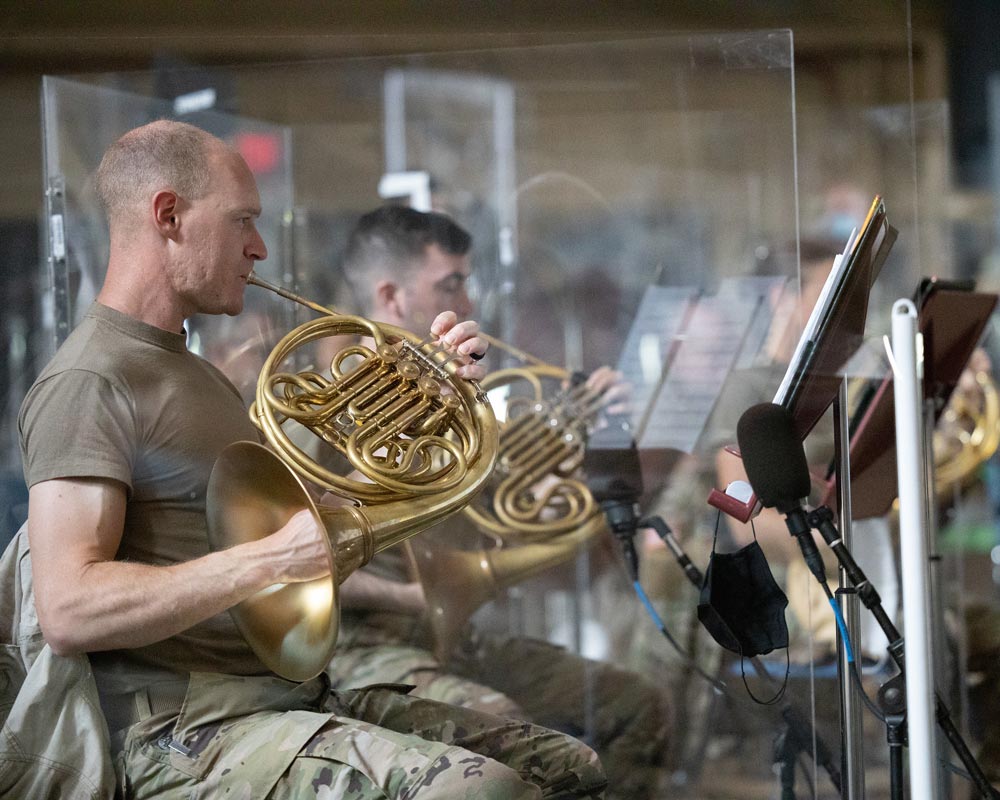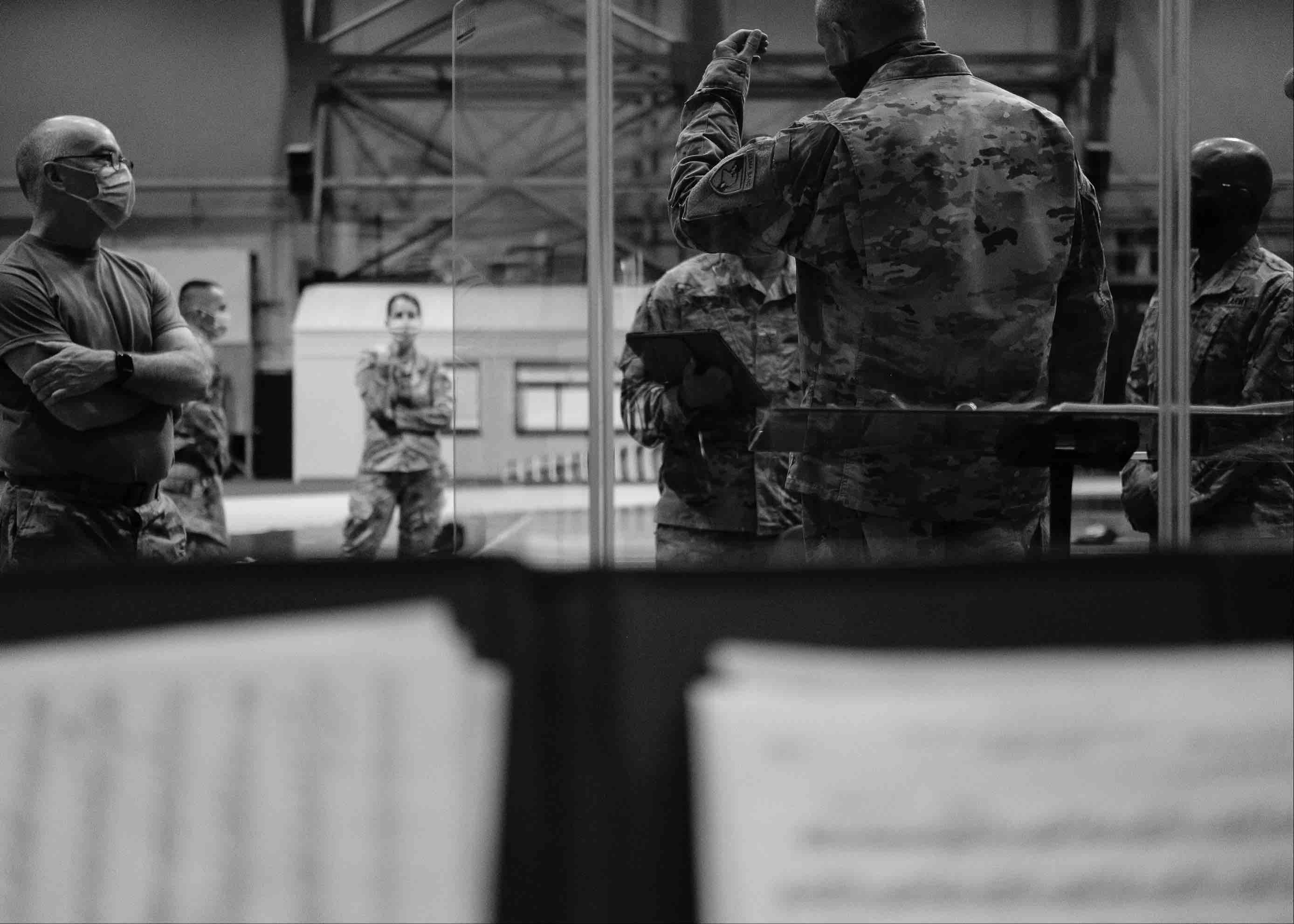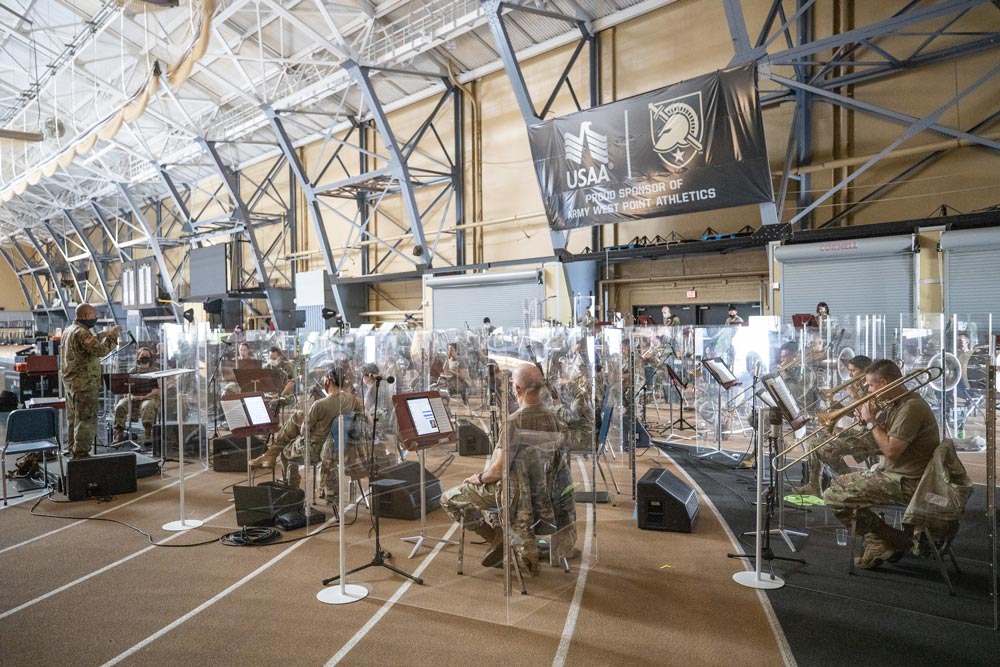
Update Sept 1, 2020
The following article describes the deliberate decision-making process undertaken by the West Point Band in providing live music to support the United States Military Academy’s 2020 Graduation Ceremony, amidst an elevated risk of airborne viral transmission. It reflects the band's approach to reduce risk of viral spread while maintaining practical needs of ensemble performance. This article is a snapshot of how the West Point Band operated during May and June of 2020, and is not the final word on how ensembles can and should safely operate during the pandemic.
The WPRMC is currently partnering with the USMA Photonics Research Center to further investigate the character of airflow and particle concentrations from musical activity. This research aims to add to the body of knowledge being created by researchers at UC-Boulder, Colorado State University, University of Minnesota, University of Cincinnati, and others.
Purpose
To describe the deliberate decision-making process undertaken by the West Point Band in returning to live music rehearsal and performance during elevated risk of airborne viral transmission (specifically the novel Coronavirus pandemic of 2020). This document is intended to serve as a guidebook for any large gathering of musicians seeking to reduce risk of viral spread while maintaining practical needs of ensemble performance.
Background
In March of 2020, the United States began to see exponential increases to coronavirus (COVID-19) cases, a large portion of which were concentrated in the greater New York City area. Fifty miles north of the city, the United States Military Academy at West Point recognized the need for swift action to protect the health of its cadets, staff, faculty, and families. The United States Corps of Cadets were told to stay home after being on Leave status during spring break. Simultaneously, the Academy stood up cross-organizational teams to ensure training could continue. Through careful and deliberate medical analysis, it was determined that a graduation ceremony could likely be held responsibly on June 13, 2020. In order to participate in graduation, the West Point Band developed a risk-mitigation plan to support the ceremony with live music.

Dual-hatted as the West Point Music Research Center (WPMRC) Director, Lieutenant Colonel Tod Addison directed the WPMRC to capture and document the body of research and methodologies utilized in preparation for a return to rehearsals and performance. The Superintendent of the United States Military Academy, Lieutenant General Darryl Williams is a leader whose previous assignment had him managing the Ebola pandemic in Africa. This experience along with the robust staff and faculty expertise helped West Point to provide a unique protective posture while also planning for the ongoing needs of the Army to train, educate, and inspire current and future Corps of Cadets. The knowledge gained from working on these cross-organizational teams, along with preliminary research studies, contributed to the guidelines contained herein.

Prior to the COVID-19 outbreak, West Point was already utilizing Microsoft Teams, so it was positioned for remote teaching and collaboration. This proved invaluable as the various departments and experts were tasked to help define, understand, and predict the next steps for decision-makers. The West Point Center for Data Analysis and Statistics started using international, national, and local data to conduct interactive, predictive analysis on infection rates.
Dr. Erin Bromage lays out the formula of infection as:
Infection = Exposure to Virus x Time
In order to reduce the risk of infection, the band must limit any possible exposure through distance and time.[1] It is unlikely for one to become infected in a large indoor space within a short time of sharing the space. Some evidence suggests that talking could be a significant mode of viral transmission. Stadnytskyi et al.[6] used laser light scattering to visualize tiny saliva droplets expelled during speech. The research did not measure droplets with viable SARS-CoV-2 (COVID-19) virus. But if one assumes the droplets contain 7 million virus particles per milliliter, then one minute of loud speech could generate more than 1,000 virus-containing droplets, which could hang in the air for eight minutes or more. Concluding, “There is a substantial probability that normal speaking causes airborne virus transmission in confined environments.”
There is agreement between all the research collected, that wind instrument playing seems to present about the same risk as normal breathing and talking. The same risk mitigation measures should be applied, such as: reducing personnel density, reducing shared-space time, and proper sanitary practices.
Application
After gathering the latest information in a rapidly-changing environment, Army Bands can rehearse and perform live music during a viral outbreak if several measures are put into place. The annexes provided go into more detail about potential stage setups and operations procedures (ANNEX C).
Future Recommendations
The studies being done in Austria and Germany have produced preliminary results that indicate playing wind instruments presents about the same amount of viral spread risk as talking and breathing normally.[2, 4] More research is being undertaken at the Mechanical Engineering Department, University of Colorado. This research will add further rigor to any possible differences in aerosol transmission between wind instruments and normal breathing. A phased approach to return to traditional ensemble rehearsal and performance is recommended. Begin by removing one mitigation measure as conditions change and expert guidance from public health officials is updated.
Prepared by The West Point Music Research Center
CW2 Jonathan L. Crane
SGM Denver D. Dill
May 29, 2020
Annexes
A. Example Stage Plot
B. Individual Example
C. Army Bands COVID-19 Operations Guidelines
#wearetraining @WestPoint_USMA Using our COVID guidebook the @WestPointBand is rehearsing and reducing risk by, thread follows.... pic.twitter.com/f4O2X5RnKs
— West Point Music Research Center (@west_research) June 1, 2020